Chapter SevenSynthesize Results and Tell a Great Story

Introduction
The final elements in the seven steps process, synthesizing your findings and telling a compelling story, can be the most fun. It is the culmination of all your hard work, and, with luck, answers the difficult question you set out to solve. Done right, your conclusions are an engaging story, supported with facts, analyses, and arguments that convince your audience of the merits of your recommended path. This can attract volunteers to your social causes, funding for your social organization or start‐up company, build harmony in your family, or boost confidence in your own career path. Good problem solving and the story telling that goes along with it make our lives better—for problem solving done well translates into action that improves our circumstances.
Of course it doesn't always work out like this. Most readers will have experienced a project at work or in a volunteer organization that got through the analysis stage, and then fizzled. Failures at the later stages of problem solving have a number of causes: where giant models are not quite finished, reams of data produced without a clear point of view, conflicting interview or market survey data, or team members at odds over the right way forward. As young consultants, we dreaded the nervous presentation of detailed results that never jelled into a real ...
Get Bulletproof Problem Solving now with the O’Reilly learning platform.
O’Reilly members experience books, live events, courses curated by job role, and more from O’Reilly and nearly 200 top publishers.

